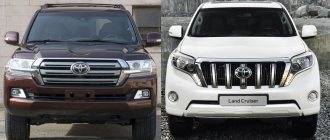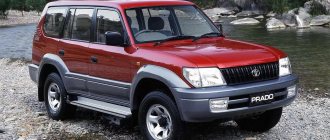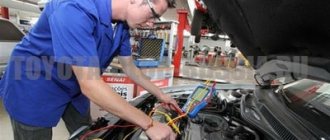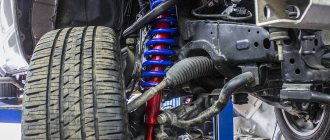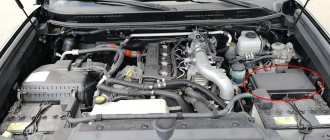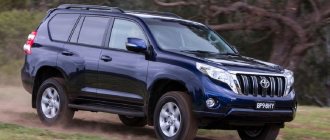Japanese products are respected all over the world, and SUVs from Toyota are no exception. They are comfortable, reliable, and even in old age they look respectable.
Toyota Land Cruiser Prado 120 is beloved in our country. Yes, it is not as luxurious as the Kruzak, but in the provinces even right-hand drive Prado 120s are a symbol of prosperity . And in remote regions with bad roads, this car cannot be replaced.
Toyota Land Cruiser Prado 120
Body and interior
Prado 120, like previous generations, is created on the 4Runner or Hilux Surf platform. From them he inherited a frame structure, two body types: 3- and 5-door. In the second case, a 3-row interior layout was used. The short modification was designated “J125”. It is equipped with two rows of seats. An additional fuel tank was not offered for such vehicles. The interior is more spacious than its counterparts due to the low floor for a frame car. In addition, the range of adjustments for the driver's seat is wide. The rear sofa is equipped with an adjustable backrest and a folding mechanism.
Compared to the previous generation, the style of the Prado 120 has been changed: the photo indicates a more streamlined design.
Most cars are equipped with arch extensions (modifications without extensions with other mudguards were supplied to some markets), some are equipped with roof rails.
Operation in winter
In cold weather the car behaves predictably. The suspension remains soft at -30-35 °C. Heavy equipment slips only on ice covered with freshly fallen snow.
Before winter operation, prepare:
- Change antifreeze.
- Diagnose the oxygen sensor. Often, under heavy loads in cold weather, the system displays the “Lean Fuel Mixture” error.
- Change oils and filters (including cabin filters).
- Insulate the engine compartment. They purchase original insulation and glue vibroplast under it.
- They “change” the car.
Winter tires are a must. Tires hold vehicles securely, especially if they are equipped with tetrahedral Bear Claw studs. Such devices provide lateral grip and stability.
The rubber compound for off-road vehicles should include rapeseed oil. It enhances traction on ice and impacts on rocks in high-riding vehicles.
Winter tires Prado 120 have a stiffening rib between the tread blocks. The grooves are smoothly polished: snow porridge slides easily. With such tires the car cannot slip. She effortlessly navigates snow-covered roads in difficult terrain. Wear indicators signal when driving becomes dangerous.
But it is difficult to overcome high snowdrifts. When the hood hits it, it jams the electronics. They shift into a lower gear and overcome the snowy mountain. Electronics behave the same way when driving in deep mud.
In winter, the interior is warm; frosts of 30 °C are not felt outside. The engine runs smoothly. The standard pre-heater keeps it at operating temperature. But it “eats” battery power.
Fuel consumption in winter increases to 17 liters per 100 km.
Arab and European cars
Prados vary depending on the target market in terms of equipment and technical specifications.
3- and 5-door versions were supplied to the Middle Eastern market. The first ones equipped the 2TR with a manual and an automatic transmission. The 5-door was offered with 2TR, 5L, 1GR. All are equipped with manual and automatic transmission.
In Europe, the Land Cruiser 120 was also offered in both body styles. The 3-door car is equipped with 1KD with manual and automatic transmission. The 5-door modification was sold with 1KD and 1GR. The first engine was equipped with both types of gearboxes, the second - only automatic.
Only a 5-door version with 3RZ, 2TR, 1KD, 5VZ, 1GR engines and automatic transmission is available on the domestic market.
One Prado configuration was supplied to the CIS: 1GR with automatic transmission.
Technical characteristics of Toyota Prado 120
In the markets of the USA, Europe and Asia, models with 4 types of gasoline engines and 3 types of diesel power units could be found on sale. The most popular engines were 2.7 liter and 3.4 liter with a performance of 163 and 150 hp, respectively. The engines were equipped with a 5-speed manual transmission and two types of automatic transmissions.
In showrooms in Russia, as well as on the Ukrainian market, one could find Prado III with only one power unit with a volume of 3995 cc. cm and a power of 249 hp. The engine accelerates the car to hundreds in just 9.1 seconds and allows it to accelerate to 180 km/h - quite enough for an SUV. The average fuel consumption of such a vehicle is about 12.4 liters per 100 km, the minimum is 9.8 liters, the maximum reaches 16.7 liters.
In the five-seater version of the car, the trunk volume in normal condition was equal to 403 liters, in the seven-seat version - 193 liters. When the rear seats were folded, the luggage compartment capacity increased to 1150 liters. This size was enough to transport large cargo and a large amount of luggage.
When tested using NCAP methods, the SUV received a score of 4 points out of 5 (27.5 points out of 37). This shows that at a speed of about 64 km/h, passengers and the driver of the vehicle may suffer minor injuries. However, serious health consequences while inside such a vehicle can be avoided.
Engines
The Toyota Land Cruiser 120 was equipped with an extensive list of 7 engines, which were inherited from the 4Runner, Hilux Surf and FJ Cruiser. Among them are 4 petrol and 3 diesel.
| Engine | Configuration, type | Volume (l) | Power (hp), at rpm | Torque (Nm), at rpm |
| 3RZ-FE | R4, gasoline | 2,7 | 150, 4800 | 235, 4000 |
| 2TR-FE | R4, gasoline | 2,7 | 163, 5200 | 246, 3800 |
| 5VZ-FE | V6, petrol | 3,4 | 185, 4800 | 294, 3600 |
| 1GR-FE | V6, petrol | 4 | 249, 5200 | 380, 3800 |
| 5L-E | R4, diesel | 3 | 95, 4200 | 129, 2200 |
| 1KZ-TE | R4, turbodiesel | 3 | 131, 3600 | 331/2000 |
| 1KD-FTV | R4, turbodiesel | 3 | 166, 3400 170, 3400 173, 3400 | 410, 2600 352, 3400 410, 2800 |
1KD is presented in different boost variants on world markets, which explains the differences in characteristics.
Lexus GX 470 was equipped with a 2UZ-FE - 4.7 liter V8 from the 100 Kruzak.
Tips for choosing (look at weak points)
When purchasing a Toyota Land Cruiser Prado, you should pay attention to the following places:
- corrosion of the frame at the points of comparison, the body along the trunk door and wheel arches;
- avoid diesel cars, and also make sure that gasoline modifications do not suffer from the consequences of overheating;
- avoid cars with “naked” electrics;
- Check the condition of steering rods, ends, levers and brake discs.
Chassis
The Prado used chassis from the 4Runner, Hilux Surf and FJ Cruiser. There is an independent suspension at the front and a dependent suspension at the rear. Compared to the previous generation, the J120 has a revised front suspension to improve reliability. The highest configuration was equipped with an adjustable rear air suspension TEMS. It provides a change in ground clearance, improving handling while maintaining comfort. According to the results of test drives and reviews, the car is focused on comfort, as evidenced by high-profile tires.
Transmission
Toyota Land Cruiser Prado 120 was equipped with 5-speed manual and 4- and 5-speed automatic transmissions A340/341E. The latest versions of the A750F series appeared in 2005 for gasoline engines. Diesels began to be equipped with a 5-speed automatic transmission and a 6-speed manual transmission in 2006. The Prado was delivered to most markets with permanent all-wheel drive, but in the Middle East modifications with a plug-in front axle were available, represented by vehicles with 3RZ and 5L manual transmissions. In the first case, a Torsen center differential is used, distributing torque in a ratio of 40/60 and equipped with a lock.
Gearbox and all-wheel drive
Almost all Toyota Prado 120, up to 2009, moving on our roads are equipped with an automatic transmission; manual transmissions are rare. Early SUVs were equipped with a 4-speed automatic transmission ; in the second half of 2004 five-speed automatic transmissions began to be installed . All gearboxes have a safety margin and can run for 200-300 thousand kilometers .
The life of the box is greatly affected by off-road driving, frequent slipping in the snow and hauling heavy trailers.
When buying an LC Prado 120, make sure that there are no shocks when changing gears, and the oil should not emit a burnt smell. The dipstick only present of the gearbox. Maintenance does not include changing the transmission oil, but practice has shown that the mechanism will work longer if the lubricant is changed every 60,000 miles .
The minimum safety margin of all-wheel drive is also 250,000 km . But it is necessary to ensure that the breather does not become clogged with dirt, otherwise the seals will begin to leak oil. Reduced lubrication levels lead to increased wear.
Rear axle gearbox
A dirty Prado 120 breather reduces the life of the gearbox.
Some TLK 120 have a differential lock . It can only be used when the situation is hopeless and the speed is less than 8 km/h .
Electrical and electronics
For the highest configuration of Prado in the domestic market, the equipment includes heated mirrors, front seats, an assistance system when starting on slopes, center locking, a stabilization system, and traction control. Sometimes there is automatic engine heating.
On the CIS market, most cars are fully equipped, including climate control, electric windows, seat adjustments, and heating. However, navigation is not available.
The electronics are simple.
Therefore, tuning of the Prado 120 Cruiser has been developed, which involves the installation of additional equipment - multimedia, audio, security systems, etc.
Advantages and disadvantages
Journalists and owners of “LK” Prado include the following advantages:
- reliability;
- simplicity;
- low price of spare parts, the ability to buy them everywhere;
- spaciousness of the cabin and trunk;
- load capacity;
- good dynamics, efficiency with a 5-speed automatic transmission with a significant resource;
- off-road capabilities (which is facilitated by large suspension travel and lower weight compared to the Land Cruiser);
- low fuel consumption for 5L and 1GR;
- good review.
There are conflicting reviews about gas mileage for the 2TR and the pre-restyled 3RZ. On the one hand, they note that in good condition it is 10-12 liters depending on the season, others say that a minimum of 15 liters is consumed, and the maximum consumption in winter exceeds 30 liters.
The disadvantages of Prado are:
- low functionality of the multimedia system in comparison with European analogues;
- poor quality of the rear view camera, which is especially noticeable in the dark - often replaced with a non-standard one;
- poor acceleration with all engines except 1GR and 1KD;
- slow 4-speed automatic;
- poor controllability, rolliness and windage, due to large weight with a high center of gravity;
- weak brakes;
- simple finishing materials;
- 2TR vibration at idle;
- weak headlights;
- poor initial configurations.
Users summarize the Prado as a car for urban use. Despite the off-road capabilities, it is not advisable to buy such a car for constant use in difficult conditions, at least in the CIS market.
The LC Prado has received 3 awards for SUV with the best consumer qualities in Australia and the USA.
Due to the official sales in Russia of one configuration, there are a large number of cars imported on the secondary market before the increase in duties. And not right-hand drive from Japan, but from the European and Middle Eastern markets. The cost, as for other Land Cruisers, is high and depends little on the year of manufacture and mileage. At the same time, Prado sales are active - the car is in demand. The price for whole cars with documents starts from 850 thousand rubles and reaches 2 million.
It's all about the owners: choose Toyota Land Cruiser Prado 120
And although the price of a used TLC 120 is now comparable to the cost of a new Vesta or Solaris in the “top”, it gives incredibly more prestige and comfort. In addition, there is a choice of gasoline and diesel engines to suit every taste, from the simplest with a hundred horsepower to a four-liter V6 with two and a half hundred horsepower. Short and long wheelbase, a good selection of options and even a seven-seater version for the long wheelbase. Classic solutions used in dozens of company models, including commercial series. The car “eats” well, in accordance with the engine size, the interior is comfortable, so is the suspension, the cross-country ability is at an excellent level and the highway habits are quite tolerable, there’s nothing to criticize too much for.
But whether the legendary reliability saves you from expenses remains to be seen.
Body and interior
The frame body structure is revered by many as the strongest and most reliable option. But in reality, the frame is not at all something indestructible, and the body design is not very successful: the floors are too high, the center of gravity is high, and the body’s rigidity is poor. And passive safety is not as good as it seems: in an accident with stationary objects or simply more significant ones, the consequences are the most severe. And only if this is a collision with a lighter car, the frame and weight will play a role.
Pictured: Toyota Land Cruiser Prado (120) '2002–09
In operational terms, not everything is fine either. The anti-corrosion treatment of the TLC 120 frame leaves much to be desired; corrosion occurs from all welding points and holes. On vehicles that were operated in Moscow and did not undergo additional anti-corrosion treatment, the frame may even be significantly weakened, even to the point of cracks appearing. The unit is important, but it has to be replaced due to unsuccessful off-road forays.
But with replacement, everything is not so simple: cars with a frame repair number, with the letters R on the edges, simply cannot be registered now. However, even before this was possible only for a “small bribe”, although there was no crime in this - this is how dealers all over Europe filled in the number.
There are many cars with damaged license plates due to corrosion, but there are also plenty of cars with a “dark” past - Toyota SUVs have long been leaders in the number of thefts. “Constructors” are now also classified as crimes - previously TLCs were considered an “eternal” machine not only for their reliability. The VIN was applied to a plate that was attached to the body with rivets, which not only official dealers had - they could easily be bought at a spare parts store. This means that the old LC could always be exchanged for a new one, illegally imported into the cut - the plate could be re-riveted at any service center. This method was especially convenient for those owners whose frame was “numberless” - the PTS stated “number not installed.”
In the photo: Toyota Land Cruiser Prado 5-door (J120W) '2002–07
Changes in legislation in recent years have literally pulled the rug out from under the feet of numerous Toyota owners in the Far East, where such “tricks” have been put on the assembly line - their cars can no longer be re-registered. When purchasing, of course, you need to pay the most careful attention to the frame number, documents, and compliance with the VIN stated in the title. It is best if the car is left-hand drive and officially sold in Russia. It’s a little worse if it’s a car from Europe, but with a normal dealer history. All other options are gradually going to Kazakhstan or being cut up, fortunately there is a high demand for spare parts, the car still remains one of the most stolen models.
On Prado, not only the frame corrodes, the body is also susceptible to this scourge. On the outside, everything is often fine, but under the false thresholds, in the places under the arches, in the places where the fastening clips are located, corrosion on city cars is already making its way through the metal with might and main. Unfortunately, many owners ignore the first manifestations, and after a few years the damage can become irreversible.
On the outside, everything is not so bad: corrosion is clearly visible only on the rear door, sometimes it crawls out from under the plastic of the sills or trims and arch extensions. No less problems await those who buy cars from the outback, anti-rooted in the old fashioned way, with bitumen and cannon fat, in the hope of better condition of the body. In fact, such barrier protection does not prevent the development of corrosion that has already begun, and dust may appear under the layer of bitumen. In general, you need to pay close attention to the condition of the body, especially on cars from the Emirates.
1 / 2
2 / 2
Otherwise there are surprisingly few problems. Rattles in the doors are either linings, or a limiter, or there is play in the hinges. The air conditioner tubes and condenser are actively corroding - the alloy is not very good; by the age of five or six years it often needs to be replaced. The main radiator also corrodes and requires replacement regularly. Moreover, it is dangerous to wash it; the structure is too flimsy and may not withstand the pressure of water from the Karcher. The windshield wiper trapezoid is also far from eternal; it can even fall apart on cars from recent years of production. The chrome of the radiator grille, mirror caps and wheel rims does not withstand even a year in Moscow, just part with it in good faith in advance.
The windshield on the Prado is a consumable item, it gets scratched easily and breaks easily. Salon problems, in addition to general pollution and poor dry cleaning, can be counted on one hand. Of the little things - the third row of seats is almost always missing, it is very inconvenient to store, it is simply removed and... lost.
The most serious problem, perhaps, is related to the climate system. If it begins to move the drives noisily and jerkily, then pay attention to the condition of the mixing damper gearmotor. It wipes the contact tracks and wears out the brushes due to the lubricant drying out. If you disassemble and lubricate it in time, it can still work for a very long time, but if not, then the price of a new part is approximately 5 thousand rubles. There is no need to remove the panel, but there will be a lot of disassembly involved. The lifespan of the heater motor is moderate, lasting about five to eight years, but replacing the brushes and restoring the bearings often helps.
1 / 3
2 / 3
3 / 3
Steering noises and knocks are usually associated with a broken steering column; its problems are quite varied, but most often the cardan crosses or elastic bushing are broken. The price of repairs ranges from a couple of thousand rubles to more than fifty, it all depends on the imagination and greed of the service. The laziest and most greedy do not bother with repairs, they offer to exchange it for a “contract” one (in fact, the part does not have any contract, it is just from disassembly or from a stolen car), at a cost of 30-40 thousand.
In the photo: Toyota Land Cruiser Prado 5-door (J120W) '2007–09
But there are no problems with the multimedia system, except for the fact that it is many times simpler here than on any European classmate, and can do literally nothing. There is a rear view camera, but those who have tried it say that it would be better not to have it. During daylight hours it can still be used, but at night the picture is reminiscent of low-budget horror films. “Non-native” cameras of varying degrees of advancedness are found on TLC Prado almost more often than “native” ones.
Electrical and electronics
The main problem, oddly enough, is the ease of maintenance of this machine subsystem. In the most remote village there will be a guy who can deal with breakdowns without scanners and other things. One problem: along the way, he will often create a bunch of other problems due to his low qualifications. Three or four blocks of collective farm xenon, five alarms, four sets of acoustic wiring - this is all the everyday life of the services that restore old Pradikas. People who rode them before didn’t fool themselves: it drives well, it shines – it’s generally excellent. Unfortunately, “collective farm style” is always somewhere next to the Prado, you should be prepared for this.
In general, the electrical part is not bad. Unless the voltage regulator here is a consumable, which on average needs to be changed every three years. It is affordable, but if it is half-dead, the battery will fail and the generator can be ruined.
Electrical problems also affect the suspension: if you have adjustable TEMS shock absorbers, their wiring may fail, and this can even be repaired. The shock absorbers themselves are also repaired, but less often, more often they install non-original ones. Another “consumable item” on cars with rear “pneumatic air” is the compressor, even with air intake from the passenger compartment its resource is very limited, usually it lasts for 150-200 thousand kilometers when driving on asphalt, and if the car drives on the ground, then the resource is lower - once every five. Sometimes the sensors on the rear axle also fail. Bursting cylinders are clearly a problem with the suspension itself, but they are also inexpensive, about 8-9 thousand rubles. Yes, this is not a Range Rover.
A few electronic problems also arise in the engine compartment: mostly these are “blooming” connectors and gasoline engine sensors. But the breakdown of the ignition switch, although not entirely “electric” in reality, is very curious and, moreover, occurs frequently. The shaft between the lock and the contact group of the lock bursts. They are trying to repair it, cook it with argon, seal it with cold welding, or simply replace it - the parts are already on sale. If you come across a non-standard Start button on the panel, you know that someone has already been “farming” with might and main.
Suspension, brakes and steering
All three nodes require increased attention. The suspension is very reliable, as long as you don’t forget that it needs to be properly maintained. You come across torn out ball joints, silent blocks torn into trash, and burst springs...
As you already understood from the last part of the article, you don’t have to be particularly afraid of pneuma: 30 thousand rubles for a pump and 8 thousand rubles for each of the air bags is not too much to pay for the extra 4 cm of rear clearance and comfort. Moreover, with some care, the system lasts quite a long time; if you do not allow dirty air into the compressor and take care of the cylinders, it can last hundreds of thousands, especially if you do not overuse primers with dust. TEMS shocks are expensive, but for a car this tall and narrow, it's a good way to provide decent highway handling while maintaining comfort. Again, worth the investment. Often they install a more advanced version of the shock absorber with TLC 150: you just need to install a different support.
In the photo: Toyota Land Cruiser Prado 5-door '2007–09
It’s difficult to say about the service life of the suspension in general: on good asphalt it is huge, but such cars are not bought for smooth roads, and often the suspension lasts for six months of good “grip” on broken asphalt. Moreover, the subframes of a passenger car would have fallen off long ago from such speeds and roads, but on the TLC you just need to change the balls and rubber bands of the levers.
One of the weak points is the wheel bearings; they are not particularly sealed, after overcoming fords they often begin to whistle, and fine dust penetrates through all the seals. And on good roads and in warm regions the resource is, again, very large.
Pictured: Toyota Land Cruiser Prado '2002–09
The brakes are distinguished by their well-thought-out design, ease of replacing pads, and the fact that discs and pads are killed regularly. The car is heavy, the brakes are small - it’s not difficult to draw a conclusion. Discs leak quite often due to their high temperature. It is very rare that the ABS unit fails. But errors in the stabilization system are often associated with errors in the steering wheel position sensor: they forget to set it “to zero” after the procedure for adjusting the camber and toe of the wheels.
Pictured: Toyota Land Cruiser Prado '2002–09
The steering is very reliable, except that the service life of the rods and ends is short, and the steering column is a bit of a hassle, as I already wrote about above. On vehicles used off-road, you should also pay attention to the fastening of the rack. Often the play of the rack itself is a couple of centimeters - of course, this has a bad effect on both the steering accuracy and the condition of its hydraulics.
Transmission
Rear driveshaft cost
price per original
29,132 rubles
In general, everything was done very, very reliably. Provided that the cardan shafts are injected regularly (if they are injected, of course), the lubricant in the axles is replaced, and the condition of the CV joint boots is monitored. All these elements still require regular replacement, but with timely maintenance, major replacements can be avoided up to a mileage of 150-200 thousand km. The transfer case also copes well with its tasks.
There are zero complaints about automatic transmissions and manual transmissions. Automatic transmissions only require timely oil changes (every 60 thousand km is optimal) and careful operation, without overheating. The automatic machines here are mainly of the A750F series; they have five stages and can hardly be called particularly conservative - they even provide good dynamics and fuel consumption. The operating algorithms are very well configured: the gas turbine engine has a long service life, the contamination of the box is low, the thermal conditions are very gentle, and in general the box can travel 200 or 300 thousand kilometers. By the way, this automatic transmission can be found on Mitsubishi Pajero, Suzuki Vitara, and Kia Sorento.
Less common are automatic transmissions of the A340/341E series, mainly with the 2.7 2TR-FE engine, but they were also installed with diesel engines and rare gasoline 3.0s. This four-step also belongs to the category of “eternal”. Ideally thought out design, good maintenance schedule. Sometimes, even in inhuman conditions, it still walks and walks in hundreds of thousands... And its design is very simple and logical.
Motors
The main engines in our market are gasoline “fours” 2.7 series 2TR–FE, V-shaped “sixes” 4.0 1GR–FE and diesel engines 1KD series, most often 1KD–FTE with a capacity of 163-173 hp. With. Less common are 1KZ diesel engines and gasoline engines of older series, mainly on cars from Asia and “designer” ones.
All engines, we must pay tribute, are distinguished by an enviable service life and viability. Provided that technical regulations are at least approximately followed, Toyotas are capable of “running” hundreds of thousands of kilometers.
The 2.7 inline four, despite its solid displacement, is perhaps the lowest resource engine. In addition, it also has several unpleasant innate features: a tendency to leak in the front oil seal, not very good cooling system pipes... And on a two-ton car, the wear on the piston group is quite large; by the time the mileage reaches 200-250 thousand kilometers, the piston parts often need to be replaced rings, and the valve clearance should be constantly monitored. The rest of the motor is surprisingly simple, logical and well laid out.
In the photo: 2TR-FE engine
If the chain life had been higher than the typical 120-150 thousand kilometers, then it could still be in the lead. The price of an “average” repair is relatively low, and boring is rarely required; the quality of the cylinder block is very high. Unfortunately, it is often worn out by driving with oil, overheated many times and barbarously operated on 92-octane gasoline or with LPG. In such cases, the cylinder head is simply dead, with cracked valve seats and large annular wear.
A more respectable 4.0-liter V6 was officially sold here, and this is a really good choice for a car. A resource of 300 thousand for 1GR-FE is quite typical, and then everything is limited by the condition of the attachments and the age of the power and cooling system. With good care, a mileage of half a million kilometers is quite achievable.
In the photo: Toyota 1GR-FE engine
Problems? Leaks, unsuccessful crankcase ventilation system, throttle contamination and attachment failures, low life of lambda probes. On the earliest engines, there was also a breakdown of the cylinder head gasket with loss of antifreeze, but now the likelihood of encountering a car with an unresolved problem is low. But with the consequences of overheating - it’s very possible. If you change the oil often, pour good oil, do not overheat, and adjust the valve clearance in time, then the engine will perform excellently.
In the photo: Toyota 1KD-FTV engine
Diesel engines 3.0 were also officially sold and are also very good, although not for the outback, but only for cities with good quality fuel. 1KD-FTE really does not like sulfur diesel fuel, low sulfur diesel without lubrication, with water and frozen. If the fuel is “not very good,” then the life of the cylinder head, injectors and fuel pump will be too short to recoup the increased purchase costs. And the EGR is also extremely capricious here. On average, injectors last for 120-150 thousand kilometers, in the best case for 200-250, all other components require frequent checking.
The situation is slightly improved by installing a heating system for the tank, fuel line and filters, an excess water separator and a fine filter. In general, among traditional Prado buyers, the engine has gained a reputation as not being particularly reliable, although essentially the problem is in the style of service, and not in the engine itself.
The most powerful version of the engine is 173 hp. With. It was also distinguished by cracks in the pistons and a short turbine life, this already looks like an outright overkill in boosting and a miscalculation by the manufacturer. Fortunately, there are very few such cars, these are only European copies from 2007. But it’s worth being vigilant, especially since if the injector is leaking, cracks will also appear on engines with less boost. To begin with, the compression in this cylinder goes away a little - at this moment you can notice the problem in time and fix it before boring and replacing the entire piston group is necessary.
In the photo: under the hood of Toyota Land Cruiser Prado 5-door (J120W) '2002–07
Summary
Overall, the Toyota Land Cruiser Prado 120 is a truly reliable car. It is very resourceful, and at the same time its design is surprisingly logical and simple. Spare parts do not incur “surcharges for second repairs,” as is customary with European brands, no double surcharges for re-sizes and repair kits, and consumables are also cheap.
In the photo: Toyota Land Cruiser Prado 5-door (J120W) '2002–07
In addition, the Toyota maintenance regulations are prescribed up to completely unrealistic mileage for European cars of 200-250 thousand km, maintenance is carried out every 10 thousand, and there are no “eternal” oils for Toyota - there are clear indications of the need for periodic replacement. In general, there is a healthy conservatism in everything.
Front fender cost
price per original
15,257 rubles
As for corrosion, the car was simply not designed for our conditions - in warm countries, the main consumers of TLC, this is not a problem at all. There, even metal without paint does not rust for years... In our country, Prado is used “for slaughter” in the literal sense, and when buying, first of all, you need to look for a car that has not been used by oil workers, construction workers, or lovers of hunting and fishing. It is better to look for a car from an area where there are good official and not so good Toyota services, because cars “from the regions” are often in such a surprisingly “knocked-out” state that the feasibility of restoration is not always obvious. Nothing can be done, like all simple and “indestructible” (and status!) cars, Prado attracts a very special type of owner.
In the photo: Toyota Land Cruiser Prado 5-door (J120W) '2002–09
And the last good news: if they give you something with a completely dead engine and transmission, but extremely cheaply, and at the same time you have a strong desire to tinker with the car for a year or two, investing 300-400 thousand, then you can be tempted. In any case, Japan still generates a steady flow of contract parts at a reasonable price.
What really matters is the frame, documents and non-criminal status. If there are problems in this regard, then, alas, it is fatal.
Survey
Would you buy a TLC Prado for yourself?
Your voice
Total votes:



